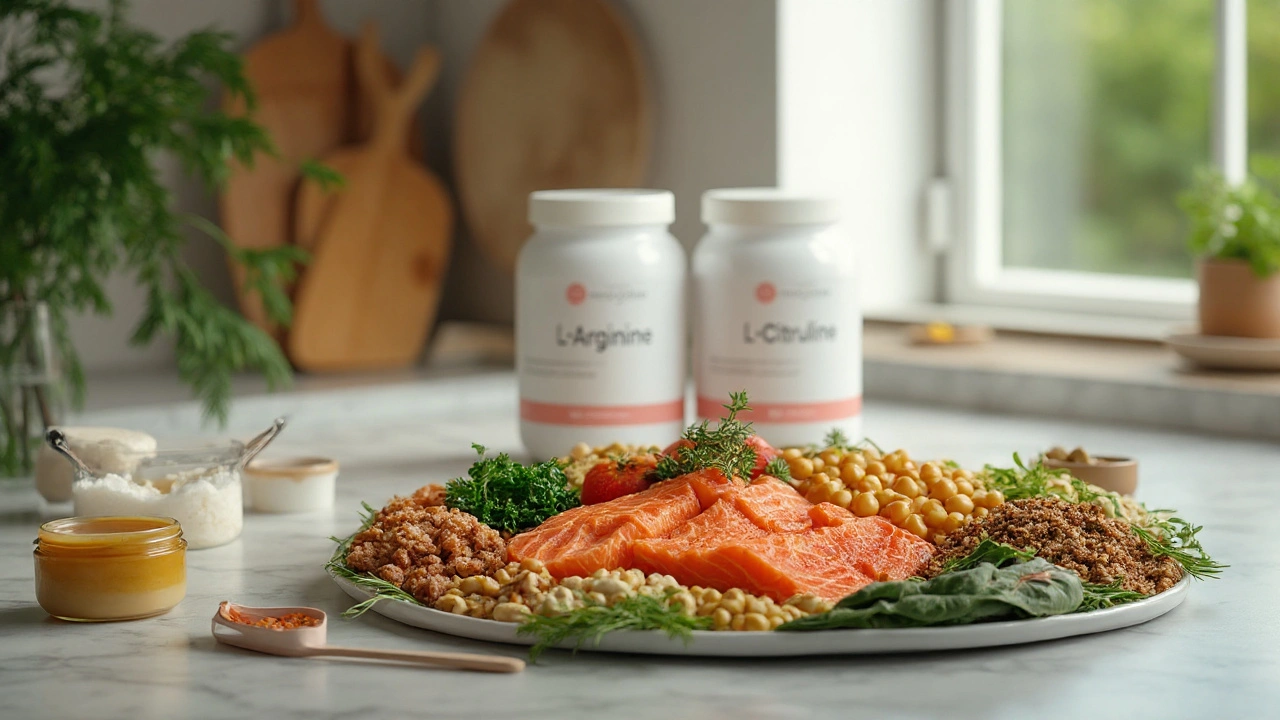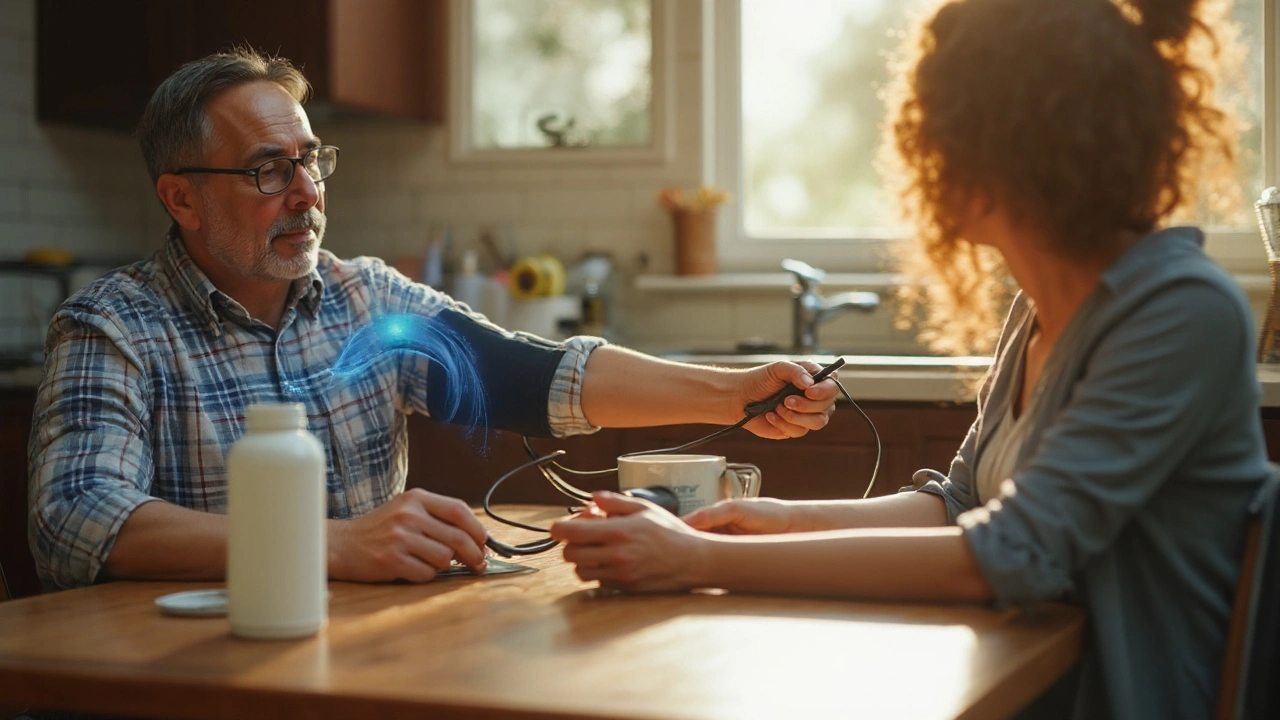TL;DR
- L-Arginine can boost nitric oxide, which relaxes blood vessels. Expect modest effects on blood pressure and erectile function, not miracles.
- Food sources first (nuts, seeds, poultry, legumes). Supplements help specific goals but need the right dose and timing.
- Typical supplement dose: 3-6 g/day split. Start low to dodge tummy issues. Avoid if you’ve had a heart attack, active cold sores, or take nitrates.
- For performance, L-citrulline often beats L-arginine. Beetroot/nitrate is another smart option.
- Track results with simple markers: home BP, morning erections, workout performance, and how you feel.
What it does, who it helps, and where the hype stops
You clicked because you want a real edge, not another shiny promise. The short version: L-arginine is a semi-essential amino acid your body uses to make nitric oxide (NO). NO tells blood vessels to relax. Relaxed vessels mean better blood flow-think blood pressure and erectile function-plus a small chance of workout benefits if you dose and time it right.
Three quick realities keep this honest. First, arginine is heavily broken down in the gut and liver before it hits your blood. That’s why “more” doesn’t always do more. Second, effects are modest for most healthy people. Third, it shines more when there’s an actual deficit in NO or increased demand (hypertension, endothelial dysfunction, or specific ED cases).
What the research says, in plain English:
- Blood pressure: Meta-analyses (e.g., 2016-2023 pooled trials) suggest small drops in systolic BP-around 2-5 mmHg-with 4-8 g/day for 4-12 weeks. That’s meaningful but not medication-level. Sources: peer-reviewed meta-analyses in nutrition and cardiology journals; NIH dietary supplement profiles.
- Erectile function: Multiple RCTs show modest improvements on standardized scores, especially at 5 g/day or when paired with antioxidants (like pine bark extract). Not a replacement for prescription meds, but can help mild-to-moderate cases. Sources: clinical trials reported in urology journals.
- Athletic performance: Mixed. Oxygen delivery matters, but arginine’s first-pass metabolism dulls the payoff. Citrulline, which converts to arginine later, usually raises plasma arginine more reliably and may improve reps or reduce perceived exertion. Sources: sports nutrition trials and position stands.
- Peripheral artery disease: Results are inconsistent and sometimes neutral. Don’t rely on arginine here without specialist guidance.
- Wound healing/collagen: Arginine plays a role in collagen and the urea cycle; specialized formulas (with arginine) can support healing in clinical settings, but that’s not DIY territory.
Safety bottom lines you should actually use:
- Avoid after a recent heart attack. A 2006 randomized trial (VINTAGE MI) found worse outcomes with post-MI arginine.
- Caution if you use nitrates (for chest pain) or combine with high-dose antihypertensives, as blood pressure can drop too low. Talk to your doctor, especially if you’re on PDE-5 meds (sildenafil/tadalafil). It’s not banned, but be sensible.
- If you get cold sores, high-arginine intakes can trigger outbreaks. Skip supplements during flares.
- Expect GI side effects if you ramp too fast: nausea, cramps, diarrhea.
Why listen to any of this? Because the physiology is textbook (arginine → nitric oxide via eNOS) and the human data-while not perfect-show consistent, modest trends. Think "helpful nudge," not "total overhaul."

How to use L-Arginine (or not) like a pro: food, dose, timing, and safer stacks
Here’s the practical part. Use this as your field guide.
Jobs-to-be-done you probably have in mind:
- Figure out if L-arginine matches your goal (BP, ED, workouts).
- Choose food vs supplement-and the dose that makes sense.
- Avoid interactions and side effects.
- Track results to know if it’s working.
- Compare it to smarter alternatives (citrulline, beetroot).
Start with food. You’ll be surprised how quickly you can move the needle with your plate.
- Pumpkin seeds: ~5-6 g arginine per 100 g (a small 30 g handful gives ~1.5-1.8 g)
- Peanuts/peanut butter: ~3 g/100 g
- Turkey breast: ~1.6-1.8 g/100 g cooked
- Chicken: ~1.2-1.5 g/100 g
- Soybeans/tofu: ~2.0-3.3 g/100 g (higher for edamame/soybeans)
- Chickpeas/lentils: ~1.0-1.4 g/100 g cooked
- Dairy and eggs: modest amounts, still useful in a mixed diet
Food-first rules of thumb:
- Build 2-3 arginine-rich anchors per day (e.g., turkey salad at lunch, tofu stir-fry at dinner, nuts as a snack).
- Spread intake across the day. Your body uses and recycles it; a trickle beats a flood.
- If cold sores are your thing, favor higher-lysine foods (yoghurt, cheese) and don’t go wild on nuts/seeds during outbreaks.
When supplements make sense:
- Blood pressure and vascular health: You’ve dialed in sleep, salt, steps, and stress, yet BP stays borderline. A 6-8 week trial can be worth it.
- Erectile function: Mild-to-moderate issues, especially if you prefer a gentler first step or a combo approach.
- Pre-workout blood flow: If you’ve tried citrulline and beetroot and want to test arginine for yourself.
Dose and timing that actually work:
- Start low: 1 g, twice daily, for 3-4 days to test tolerance.
- Target range: 3-6 g/day total, split in 2-3 doses (morning and late afternoon). Some ED studies use up to 5 g once daily; consider splitting if your gut complains.
- Timing: 30-60 minutes pre-workout if using it for training; otherwise morning/early evening is fine.
- With or without food: Empty stomach may absorb better; with food is gentler on the gut. Pick your poison.
- Hydrate and keep electrolytes steady. Loose stools are your sign to back off.
Which form?
- L-arginine base vs HCl: HCl is common and more stable; it contains slightly less elemental arginine by weight. Don’t overthink it-dose by the label’s stated elemental arginine.
- Capsules vs powder: Powder is cheaper per gram, caps are convenient. In Australia, you’ll find both at chemists and sports nutrition stores. Expect ~A$25-45 for 500 g powder; capsules vary by dose/count.
Smart stacks (and why):
- L-citrulline (3-6 g/day, or 6-8 g citrulline malate): Often raises plasma arginine more reliably than arginine itself. Better bet for performance and pumps in many people.
- Beetroot/nitrate (e.g., 400-800 mg nitrate from 70-140 mL concentrated shots): Evidence-backed for endurance and BP. Easy to stack, different pathway.
- Vitamin C or polyphenols (berries, cocoa): Can support NO bioavailability by reducing oxidative stress.
Stacks to approach with caution:
- Nitrates (medication) or multiple blood-pressure drugs: Risk of excessive BP drop. Doctor first, always.
- PDE-5 inhibitors (sildenafil/tadalafil): Many men use the combo without drama, but monitor blood pressure, start low, and clear it with your GP.
- During pregnancy/breastfeeding: Not DIY. Talk to your provider.
Who should skip supplements or get medical advice first:
- You’ve had a heart attack in the last few months.
- You’re prone to cold sores (HSV) and currently in an outbreak.
- You have advanced kidney or liver disease.
- You get migraines from vasodilators, or you have unstable blood pressure.
How to tell if it’s working (simple tracking plan):
- Blood pressure: Measure at home, same time daily, seated, 3 readings averaged. Look for a consistent 2-5 mmHg drop after 3-4 weeks.
- ED: Track morning erections and sexual function using a simple 1-5 score. Reassess weekly.
- Workouts: Pick a repeatable test (e.g., 10-rep bench at 70% 1RM, 5 km run split). Log perceived effort and performance.
- Side effects: Note any GI issues or headaches. Adjust dose or timing.
What official bodies say (useful context):
- NIH Office of Dietary Supplements: Arginine supports NO and vasodilation; evidence is mixed-to-modest depending on the outcome.
- American Heart Association: Lifestyle, meds, and risk control are first-line for hypertension; supplements can be adjuncts, not replacements.
- Australian context (2025): Arginine-containing products are widely available as listed medicines/sports supplements. Follow TGA-listed directions on local products and talk to your GP if you’re on prescription meds.
| Goal | What it might help | Typical dose | Evidence quality | When to expect changes | Not ideal if… |
|---|---|---|---|---|---|
| Lower blood pressure | Small SBP/DBP reductions | 4-6 g/day split | Moderate (meta-analyses show modest drops) | 3-8 weeks | On nitrates; unstable BP; recent MI |
| Erectile function | Mild-to-moderate ED | 3-5 g/day (some use 5 g) | Moderate (several RCTs) | 2-6 weeks | Combine with meds only under guidance |
| Workout performance | Blood flow, pump | 3-6 g, 30-60 min pre-workout | Low-to-mixed (citrulline often better) | First session to 2 weeks | Expectations too high; GI sensitivity |
| Endothelial health | Flow-mediated dilation | 3-6 g/day | Moderate in at-risk groups | 4-12 weeks | Advanced vascular disease without medical input |

Your action plan: step-by-step, examples, checklists, and quick answers
Step-by-step setup (takes 5 minutes):
- Pick your primary goal: BP, ED, performance, or curiosity.
- Choose your route: food-first only, or a 6-8 week supplement trial.
- Baseline: Record 1 week of BP, mornings/ED notes, or a workout test.
- Start dose: 1 g twice daily for 3-4 days; then move toward 3-6 g/day if tolerated.
- Timing: Pre-workout or morning/late afternoon; split doses for smoother levels.
- Track: Check your chosen metric weekly. Don’t chase daily noise.
- Decide at 6-8 weeks: Keep, adjust (switch to citrulline or add beetroot), or stop.
Two real-world examples:
- Hypertension edge case: A 52-year-old with home BP ~138/86 after fixing salt and steps tries 2 g morning and 2 g late afternoon for 8 weeks. Average BP nudges to ~133/82. Keeps it alongside lifestyle changes; reviews meds with GP.
- Gym lifter chasing a pump: Takes 6 g citrulline malate + 3 g arginine 45 minutes pre-lift. Sees better feel and 1-2 extra reps on push day. If gut protests, drops arginine and keeps citrulline.
Quick checklists you can actually use:
Buy smart
- Choose brands that clearly list elemental arginine per scoop/capsule.
- Avoid proprietary blends with mystery doses.
- Third-party tested (e.g., Informed Sport) is a nice plus for athletes.
- Powder for value; capsules for convenience. Prices in Australia are usually fair-no need to overpay.
Safety scan (60 seconds)
- Any heart attack in the last few months? Skip and see your doctor.
- On nitrates or lots of BP meds? Doctor first.
- Cold sores active? Pause arginine.
- Bad GI history with amino acids? Start at 1 g/day and inch up.
Better alternatives, depending on goal
- BP focus: Beetroot/nitrate products or Mediterranean-style diet + exercise + sleep. Arginine can be the sidekick.
- ED focus: Lifestyle (weight, sleep, alcohol), treat blood pressure and glucose, consider PDE-5 meds. Arginine helps some, but it’s not the hero for everyone.
- Performance: Citrulline malate is usually the first stop. Beetroot for endurance days.
Food mini-plan (Melbourne-friendly, easy swaps):
- Breakfast: Greek yoghurt with berries and a tablespoon of pumpkin seeds.
- Lunch: Turkey or tofu salad with mixed greens and chickpeas.
- Snack: A small handful of peanuts or almonds.
- Dinner: Stir-fry with tofu or chicken, edamame, and veggies. Brown rice or soba on the side.
Mini-FAQ
- Is arginine banned in sport? No. It’s allowed by WADA.
- Will it “boost growth hormone”? Not in any meaningful way for trained adults at typical doses.
- Can women take it? Yes-same physiology. The considerations (BP meds, pregnancy) still apply.
- How long until I notice something? A few workouts for performance feel; 3-8 weeks for BP; 2-6 weeks for ED.
- Do I need cycling? Not required. If you feel it fades, take a 1-2 week break or switch to citrulline/beetroot.
- Can I just eat more nuts? Totally reasonable. If you need targeted effects, food plus a measured supplement trial is cleaner.
Last thought to keep you honest: supplements should tidy up the last 10-20%, not replace sleep, steps, diet, or your doctor’s plan. The nice thing about arginine is you’ll usually know in a month or two whether it’s your thing. If it is-great. If not-no harm moving to citrulline or beetroot, which often deliver more for the same effort.


Kaushik Kumar
August 29 2025Alright, team, let’s dive into the L‑arginine chat - it’s a game‑changer for circulation, it can lift that blood pressure a notch, and yes, it might add a little spark in the bedroom, but remember: consistency beats hype, start low, watch your gut, and stay hydrated, folks, you’ll thank yourself later!